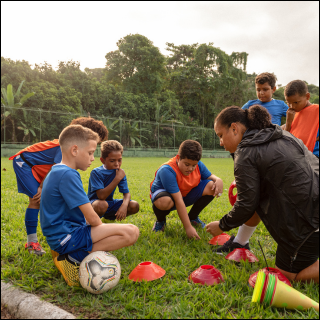Back-to-School: How to Know When Your Child Needs a Safe Adult
- Rachel Gilmore
- 4 days ago
- 4 min read
Updated: 23 hours ago
By Safe from the Start Supervisor Bianca Gonzalez and Trauma Therapist Valerie Katz

As we send our children back to school, it’s important to be mindful of their emotional and psychological safety, not just their physical well-being. Sometimes, children don’t have the words to explain when something feels wrong. That’s why it’s vital for parents and caregivers to recognize the signs that a child may need a safe adult, someone they can trust to listen, protect and help them navigate difficult situations.
Signs a Child May Need a Safe Adult
Children might not always speak up directly, but their behavior often tells a story. Look for these key indicators:
Discomfort around certain people - Watch for signs of unease, nervousness or avoidance when your child is around specific individuals. They may suddenly not want to go to certain places or spend time with certain people without being able to clearly say why.
Reluctance to be alone - A child who once enjoyed independence might now insist on being around adults or siblings constantly, particularly when certain individuals are nearby.
Secretive behavior - If your child starts keeping secrets, especially those that involve adults or situations that make them feel uneasy, it’s a red flag. Phrases like “I can’t tell you” or “I promised not to say anything” should be explored gently but seriously.
Mood or behavior changes - Sudden shifts in mood, increased anxiety, withdrawal from favorite activities, sleep disturbances, or unusual irritability can all signal distress. These changes are especially concerning if they seem to occur after spending time with a specific person or in a particular setting.
Boundary concerns - Be alert to situations where a child is asked to keep secrets, especially when tied to behavior that makes them feel uncomfortable. Pay attention to any adult who tries to create a “special relationship” or asks your child to spend time alone with them regularly, particularly if it involves secrecy.
What You Can Do as a Parent?
Create open communication - Let your child know they can talk to you about anything, without fear of punishment or judgment. Model this by staying calm and supportive when they do open up.
Normalize talking about boundaries - Teach your child that it’s okay to say “no,” even to adults. Reinforce that their body, feelings and personal space are theirs to protect.
Identify safe adults together - Help your child name a few trusted adults, both in and outside the family, who they can go to when they need help. These might include teachers, relatives, school counselors or family friends.
Trust your instincts - If something seems off, investigate gently. You know your child better than anyone else, and their safety depends on your advocacy.

Helping Your Child Identify a Truly Trusted Adult
It’s essential that children know who they can turn to, but it’s just as important to teach them
what qualities make someone genuinely safe and trustworthy. While we often refer to teachers, counselors, coaches, grandparents or family friends as “trusted adults,” children must learn how to recognize safe behavior, not just familiar faces.
Here are some qualities of a safe, trusted adult:
Listens without judgment - They allow your child to express their feelings and concerns without interrupting, minimizing or blaming.
Respects boundaries - They don’t force hugs or touch, and they respect when a child says "no" or expresses discomfort.
Supports, doesn’t manipulate - They offer help and guidance without using guilt, pressure or secrecy to control your child.
Doesn’t ask for secrets - A safe adult will never ask a child to keep secrets, especially ones that feel confusing, uncomfortable or involve touch, time alone or special favors.
Is dependable and consistent - They keep promises, show up when they say they will and their behavior is steady and respectful over time.
Balance awareness with trust - As parents, it’s important to teach children that even someone labeled as “trusted” can sometimes act in unsafe ways. That’s why we should guide them to pay attention to how someone makes them feel not just who that person is. You can say something like “Just because someone is a teacher or a coach doesn't always mean they're safe. Safe adults make you feel heard, protected and never scared or confused.”
Teach your child to trust their instincts - Children often have strong instincts, but they may doubt themselves, especially when someone in authority is involved. Encourage them to pay attention to their inner voice:
“If something feels weird, wrong or makes your tummy hurt, you can always tell me.”
"You never have to keep a secret that makes you feel scared or uncomfortable.”
Help your child understand that it’s okay to say no, walk away or come to you, even if they’re not sure why they feel uncomfortable.
When we teach kids to recognize red flags and listen to their instincts, we empower them to protect themselves and ask for help when they need it most.

To Ease Bus and Getting to School Anxiety
It’s completely normal for children to feel a little anxious about riding the bus or getting to school in the first few days. Help ease their nerves by:
Validating their feelings – Let them know it’s okay to feel nervous or unsure.
Practicing routines together – Walk to the bus stop, talk through what to expect and rehearse safe behavior step-by-step.
Expressing your confidence – Remind them that you believe in their ability to handle this new routine, and that you’ll be there to support them.
Bus Safety Tips
Arrive early.
Get to the bus stop at least 5 minutes before the scheduled time to prevent rushing and unsafe behavior.
Stay back from the curb.
Teach your child to stand at least three giant steps (about 6 feet) away from the road until the bus comes to a complete stop.
Board safely and calmly.
Wait until the bus has fully stopped, then board in a single line without pushing or running.
Stay seated during the ride.
Encourage your child to stay in their seat, use quiet voices and avoid distracting the driver.
Be respectful and kind.
Remind children to treat others kindly on the bus, follow the driver’s instructions and speak up if something doesn’t feel right.
For more information or questions, contact CAC's Mental Health Services team at bgonzalez@cachelps.org.




Comments